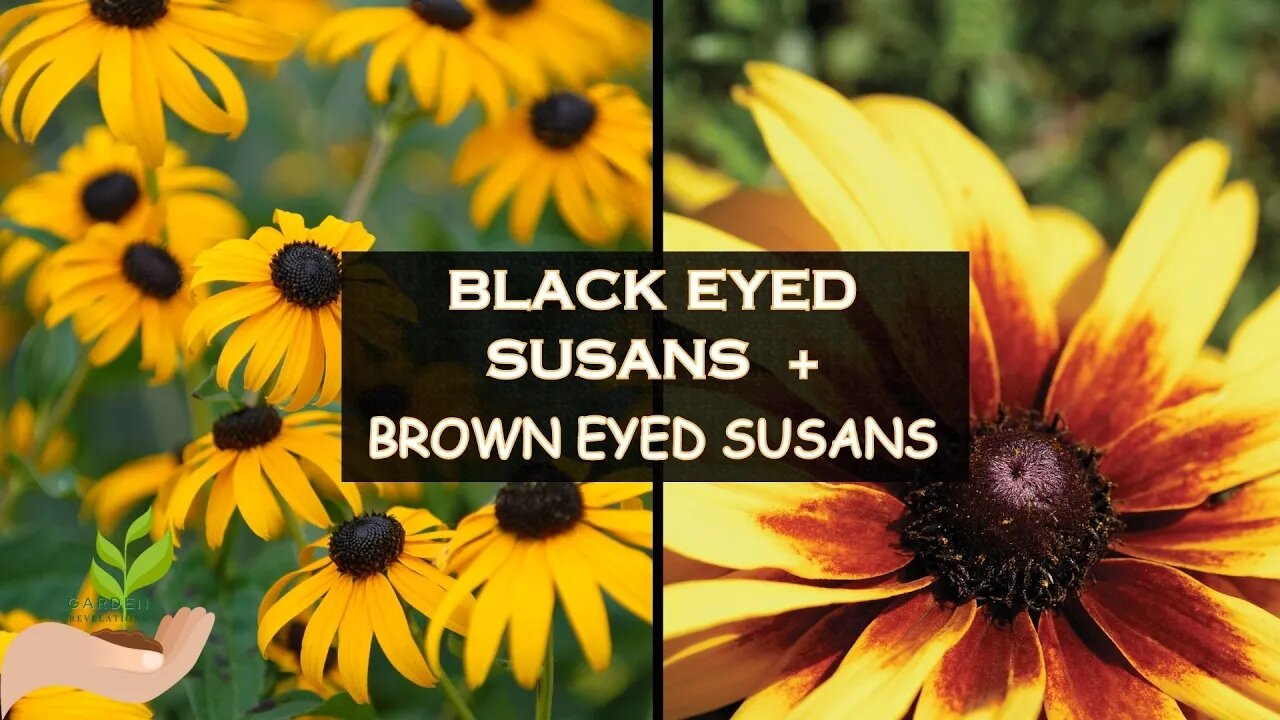Premium Only Content

BLACK EYED SUSANS + BROWN EYED SUSANS: Delightful native wildflowers for the garden
Black-Eyed and Brown-Eyed Susans: Delightful Native Wildflowers for Your Garden.
Black-eyed Susans and brown-eyed Susans are beloved native wildflowers known for their bright, cheerful blooms and resilient nature. These hardy perennials are popular among gardeners seeking to add a touch of natural beauty to their outdoor spaces. Let's explore these captivating plants' characteristics, growing zones, planting, care, and maintenance.
Colors and Appearance.
Both black-eyed and brown-eyed Susans feature daisy-like flowers with a dark central cone surrounded by colorful rays. Black-eyed Susans (Rudbeckia hirta) has bright yellow to orange petals with a dark brown or black center. In contrast, brown-eyed Susans (Rudbeckia triloba) have yellow petals with a brown center. The leaves of these plants are lance-shaped, often with a rough, hairy texture. Mature plants can reach heights of 2 to 3 feet, depending on the variety.
Growing Zones and Environmental Conditions.
Black-eyed and brown-eyed Susans are native to North America and thrive in USDA plant hardiness zones 3 to 9. These resilient perennials prefer well-draining soil with a pH of 6.0 to 7.0. While they can tolerate partial shade, they grow best in full sun, requiring at least 6 hours of direct sunlight daily.
Latin Names.
The Rudbeckia genus, including black-eyed and brown-eyed Susans, contains several species and cultivars. Some of the most commonly grown varieties are:
Rudbeckia hirta (Black-Eyed Susan).
Rudbeckia triloba (Brown-Eyed Susan).
Rudbeckia fulgida 'Goldsturm' (Goldsturm Black-Eyed Susan).
Pollinators They Attract.
Black-eyed and brown-eyed Susans are magnets for pollinators such as bees, butterflies, and even hummingbirds. They provide a rich source of nectar and pollen, making them a valuable addition to a pollinator-friendly garden.
When to Plant.
The best time to plant black-eyed and brown-eyed Susans is in the spring or early fall, allowing the plants to establish a robust root system before the summer heat or winter cold.
Planting, Care, and Maintenance.
Prepare the planting site by loosening the soil to a depth of 12 to 15 inches and incorporating compost or other organic matter to improve drainage and fertility.
Space plants 18 to 24 inches apart to ensure adequate air circulation and room for growth.
Water regularly during the first growing season to help the plants establish a deep root system. Once established, these perennials are drought-tolerant and require minimal watering.
Apply a layer of mulch around the plants to help conserve moisture and suppress weeds.
Deadhead spent flowers to encourage continuous blooming and maintain a neat appearance.
Fertilize with a balanced, slow-release fertilizer in early spring to support robust growth and flowering.
Divide mature plants every 3 to 4 years in the spring or fall to maintain vigor and promote healthy growth.
Black-eyed and brown-eyed Susans are a delightful addition to any garden, offering a cheerful display of color and a valuable resource for local pollinator populations. By following the planting and care guidelines outlined above, you can create a thriving, eye-catching display in your garden that lasts many years. These charming native plants bring beauty, color, and helpful pollinators to your yard.
PURCHASE NON GMO BLACK-SUSAN SEEDS: https://amzn.to/3mlJUoI
As an Amazon Associate I earn from qualifying purchases.
Connect with us
Facebook: https://www.facebook.com/TayloesLawnCare
Web: https://www.tayloeslawncare.com
MeWe: https://mewe.com/p/diyhomegarden
Image and music licensed via Canva Pro
-
 0:58
0:58
Garden Revelations
1 year agoTIGER LILY: A gorgeous, easy-care, drought-tolerant perennial daylily to try in your flower garden
97 -
 55:28
55:28
Glenn Greenwald
7 hours agoGlenn Reacts to Trump-Zelensky Exchange and Takes Q&A from our Members | SYSTEM UPDATE #415
101K186 -
 4:26:54
4:26:54
Nerdrotic
9 hours ago $29.33 earnedMarvel PANIC MODE! Kathleen Kennedy GONE?! Hollywood DEI Dead | Friday Night Tights 342 Nick Freitas
118K32 -
 1:30:03
1:30:03
Flyover Conservatives
23 hours agoZelensky Fail... God Called IT!; From Prison to the White House: Angela Stanton King’s Unbelievable Redemption Story | FOC Show
39.6K5 -
 1:06:14
1:06:14
IsaacButterfield
9 hours ago $1.47 earnedFree Speech Is Dead | Did Trump Go Too Far? | Sexist Job
37.5K17 -
 1:02:59
1:02:59
Sarah Westall
11 hours agoEpstein Files, Dueling Cabal Factions and Gold from Ancient Civilizations w/ Dave Hodges
67.5K18 -
 LIVE
LIVE
I_Came_With_Fire_Podcast
9 hours ago“Trump-Zelensky BEATDOWN | Europe BUILDS MUSCLE | NEWSCUM Podcast”
385 watching -
 41:25
41:25
CatfishedOnline
10 hours ago $1.23 earned23-Yr-Old Drove 2,650 Miles to Meet Online Girlfriend in Romance Scam
38.2K3 -
 1:56:18
1:56:18
Bare Knuckle Fighting Championship
2 days agoCountdown to BKFC FIGHT NIGHT ALBUQUERQUE & FREE LIVE FIGHTS!
34.3K2 -
 1:58:08
1:58:08
Anthony Rogers
9 hours agoHow To Beat Kids At Video Games
11.8K1